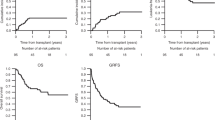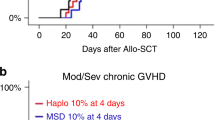Abstract
The use of allogeneic BMT in patients with relapsed non-Hodgkin lymphoma (NHL) offers the advantage of tumor-free bone marrow and possibly a ‘graft-versus-lymphoma effect’ which may decrease the risk of recurrence. However, allogeneic BMT also poses an increased risk of death due to graft-versus-host disease (GVHD) which can be ameliorated by T cell depletion. We performed a retrospective review of 37 patients who underwent T cell-depleted allogeneic BMT for aggressive and indolent NHL between 1988 and 1996. Polymerase chain reaction (PCR) was used to identify indolent NHL patients with the BCL2/IgH translocation which served as a marker of residual disease. Sixteen of 37 patients (44%) are alive and progression-free with a median follow-up of 4.4 years (range 1–10.3). The incidence of grade 2–4 acute GVHD was 36% and extensive chronic GVHD developed in 12%. Patients with aggressive NHL have an overall PFS of 33% (12–54%); those with chemotherapy-resistant and sensitive disease have PFS of 17% (0–47%), and 40% (15–65%) respectively at 5 years. Patients with indolent histologies have overall PFS of 62% (37–86%); those with chemotherapy-resistant and sensitive disease have PFS of 55% (25–85%) and 80% (45–100%) respectively at 5 years. Eight patients with indolent disease had a BCL2/IgH translocation detectable by PCR. Five of these eight patients remain alive and progression free at a median of 6.5 years after BMT (range 2.1–7.4 years), four of whom remain PCR positive from 1.7 to 2.9 years after transplantation. We conclude that T cell-depleted allogeneic BMT poses a low risk for death due to GVHD, and should be considered for patients with relapsed and refractory indolent NHL.
This is a preview of subscription content, access via your institution
Access options
Subscribe to this journal
Receive 12 print issues and online access
$259.00 per year
only $21.58 per issue
Buy this article
- Purchase on Springer Link
- Instant access to full article PDF
Prices may be subject to local taxes which are calculated during checkout
Similar content being viewed by others
Author information
Authors and Affiliations
Rights and permissions
About this article
Cite this article
Juckett, M., Rowlings, P., Hessner, M. et al. T cell-depleted allogeneic bone marrow transplantation for high-risk non-Hodgkin’s lymphoma: clinical and molecular follow-up. Bone Marrow Transplant 21, 893–899 (1998). https://doi.org/10.1038/sj.bmt.1701209
Received:
Accepted:
Published:
Issue Date:
DOI: https://doi.org/10.1038/sj.bmt.1701209
Keywords
This article is cited by
-
Second-line age-adjusted International Prognostic Index in patients with advanced non-Hodgkin lymphoma after T-cell depleted allogeneic hematopoietic SCT
Bone Marrow Transplantation (2010)
-
The implication of follicular lymphoma patients receiving allogeneic stem cell transplantation from donors carrying t(14;18)-positive cells
Bone Marrow Transplantation (2005)
-
Reduced-intensity conditioning prior to allogeneic transplantation of hematopoietic stem cells: the need for T cells early after transplantation to induce a graft-versus-lymphoma effect
Bone Marrow Transplantation (2004)
-
Allogeneic peripheral blood stem cell transplantation for high-risk non-Hodgkin's lymphoma
Bone Marrow Transplantation (2003)
-
Tumor load in patients with follicular lymphoma post stem cell transplantation may correlate with clinical course
Bone Marrow Transplantation (2003)



